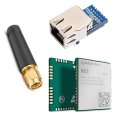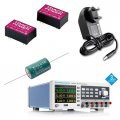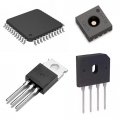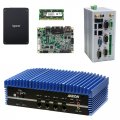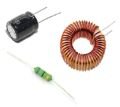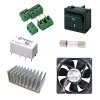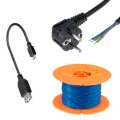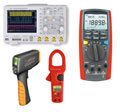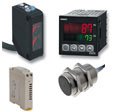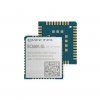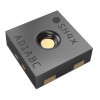La monitorización de una ubicación remota es una aplicación habitual de IoT, pero las necesidades pueden variar en cada caso. A veces, aunque los parámetros observados no cambian rápidamente y no son críticos en sí, los propietarios solicitan actualizaciones periódicas, por ejemplo, cada pocas horas. Tomemos como ejemplo un «sensor de árbol», una solución IoT que monitoriza el estado de salud de los árboles. Estos sensores resultan muy útiles en zonas agrícolas cultivadas, por ejemplo, en explotaciones de frutos secos. Con este fin se monta un dispositivo IoT con sensor alimentado por batería en un árbol de referencia donde se recaban algunos datos medioambientales como la humedad (o sequía), una información fundamental para que los propietarios de las plantaciones optimicen el crecimiento, el rendimiento, etc.

Por lo general, estos sensores de árbol se implementan en lugares donde no se dispone de fuentes de alimentación ni redes de área local. Por lo tanto, en este tipo de usos, los dispositivos IoT deben funcionar con una batería y una red móvil que permita la utilización prácticamente en cualquier lugar. Además, el sensor de árbol debe estar preparado para un funcionamiento sin intervención humana durante todo el ciclo de vida del producto, es decir, debe ser 100 % libre de mantenimiento y no debe necesitar sustitución ni recarga de batería durante muchos años. Esto significa que nuestro sensor IoT debe estar diseñado para lograr la máxima eficiencia energética.

- un dispositivo de medición de nivel de llenado de un silo o
- un sensor de flujo de líquido que informa sobre el uso y detecta fugas en tuberías o
- dispositivos para diversas aplicaciones de vigilancia y detección de objetos o
- un seguidor de activos que proporciona la geolocalización de un objeto móvil de valor
Estas son aplicaciones «push» habituales en las que el dispositivo IoT está inactivo la mayor parte del tiempo, y simplemente «se despierta» ocasionalmente en función de un horario fijo o un evento externo. NB-IoT es una tecnología de red móvil (LPWAN = red de área amplia de baja potencia) que se ha especificado especialmente para cumplir con este tipo de requisitos, sobre todo si se utilizan dispositivos IoT fijos para la transmisión poco frecuente de pequeños paquetes de datos de carga útil.

El especialista en sensores ambientales Sensirion ofrece una amplia gama de productos para una serie de parámetros como humedad, temperatura, compuestos orgánicos volátiles (COV), NOx (óxido de nitrógeno), formaldehído y CO2. Todos ofrecen interfaces I2C para una fácil integración en dispositivos IoT y modos de bajo consumo para aplicaciones a batería.
Para una mejor protección frente a condiciones medioambientales duras, la antena NB-IoT debe montarse dentro de la cubierta del dispositivo IoT. Para ello, 2J Antennas ofrece los adhesivos y productos de pequeño tamaño necesarios para una solución integrada.

Figura 1: Sensor medioambiental NB-IoT alimentado por batería - Diagrama de bloques
Nota: SOS electronic es un proveedor cualificado de productos Quectel, Sensirion y 2J Antennas. Para completar la solución IoT de bajo consumo, SOS electronic también ofrece una amplia gama de baterías de litio de Fanso, Xeno y EVE.
Diseño de potencia mínima con NB-IoT y Quectel BC66
Para apoyar la reducción del consumo de energía del dispositivo IoT todo lo posible, la tecnología de red NB-IoT ofrece una característica eficiente llamada modo de ahorro de energía (PSM) que permite a los dispositivos NB-IoT desactivar la mayoría de los elementos de la interfaz de red, incluida su sección de RF de transceptor durante un período de inactividad acordado.
La duración de este intervalo la determina el temporizador de red T3412 (o «temporizador TAU»), que el dispositivo NB-IoT utiliza sobre todo para realizar periódicamente una actualización del área de seguimiento (TAU). Esta es una función estándar de LTE que notifica la disponibilidad de un dispositivo de usuario a la red conectada. Una vez que el dispositivo se ha conectado correctamente a la red, permanece registrado durante los intervalos de PSM, pero la actividad de transmisión espera hasta que expire el temporizador T3412. Por naturaleza, los períodos más largos de PSM dan como resultado un menor consumo de energía. Dependiendo de la aplicación de IoT, ahora depende del desarrollador determinar el período de tiempo ideal para que el dispositivo permanezca en modo PSM. De acuerdo con la especificación 3GPP, T3412 se puede programar para intervalos de PSM de hasta 413 días (!).

Figura 2: Actividad periódica del dispositivo (simplificado)
Durante los períodos de PSM acordados, la red almacenará en búfer todo el tráfico de descarga al dispositivo IoT registrado pero fuera de su alcance. Nuestro concepto de diseño para un dispositivo «push» alimentado por batería se basa en un único intervalo de tiempo periódico (ver la figura 2) durante el cual se realizan todas las actividades locales de IoT, es decir, la lectura del sensor, la recepción de mensajes pendientes (p. ej., un comando de control remoto del operador) y la transmisión de datos de carga útil de IoT. La mayor parte del tiempo (aprox. el 99,99 %), el dispositivo permanece en modo de suspensión profunda, durante el cual consume unos pocos µA. Una vez finalizado T3412, el módulo Quectel BC66 recupera los mensajes pendientes de la red, si los hay. Durante los eventos de recepción, el módulo consume alrededor de 30 mA; durante la transmisión de enlace ascendente, consume incluso alrededor de 200 mA con una potencia de salida de 23 dBm. Con el tiempo, la frecuencia y la duración de estos picos de consumo breves tiene un impacto significativo en la vida útil de la batería. No es de extrañar que, al duplicar la frecuencia de los períodos de actividad (por ejemplo, de una vez al día a dos veces al día), se reduzca la vida útil de la batería a la mitad.
Pero, además, hay otros muchos aspectos que contribuyen al consumo total de energía del dispositivo. Por ejemplo, el acoplamiento de posición e impedancia de la antena del dispositivo es un aspecto muy importante del diseño, que tiene un impacto significativo en el rendimiento de RF. El acoplamiento de antenas es necesario para maximizar la potencia de salida en una determinada frecuencia portadora de NB-IoT. En general, la ubicación del dispositivo tiene un impacto en el consumo de energía y la distancia a la torre de antena conectada debe ser lo menor posible para maximizar la eficiencia y la calidad de la señal. Se trata de una cuestión crucial porque debe evitarse el funcionamiento de dispositivos alimentados por batería en el nivel 2 de extensión de cobertura (CE). Esta función de NB-IoT es útil para ofrecer cobertura en áreas de difícil acceso, pero funciona con repeticiones y códigos adicionales de corrección de errores que aumentan enormemente la sobrecarga de datos de carga útil y los tiempos de transmisión. Por tanto, desde el punto de vista de la implementación, es beneficioso trabajar con un MVNO (operador de red «virtual») que permite seleccionar entre una serie de redes para conectarse, en lugar de solo una. En la figura 5 encontrará una explicación más detallada de estos temas.
Quectel BC66 ofrece varias opciones que ayudan a diseñar dispositivos de bajo consumo aprovechando la función PSM de NB-IoT (ver la Referencia 2). El dispositivo IoT puede solicitar a la red NB-IoT la entrada en el estado PSM a través del comando AT, lo que permite que el dispositivo entre en suspensión profunda durante el intervalo de PSM acordado. En el modo de suspensión profunda, la interfaz UART no funciona y solo hay dos formas de devolver el módulo a un estado activo: la finalización del temporizador TAU periódico interno o un evento de activación externo.
Los eventos de activación externos se indican alternando el terminal PSM_EINT del módulo Quectel BC66. Este método se puede utilizar para un evento local predefinido, p. ej., un umbral superior (por ejemplo, diciendo «hace demasiado calor») o la detección de presencia de un objeto. Esta es otra aplicación «push» habitual de IoT que el Quectel BC66 lleva a cabo por sí solo o en colaboración con una red NB-IoT. Pero para nuestro ejemplo de «sensor de árbol» usamos el temporizador TAU periódico interno mencionado para encender.

El concepto de un dispositivo «push» alimentado por batería
Durante los períodos de PSM acordados, todos los componentes del dispositivo se configuran para funcionar en sus diferentes modos inactivos con un consumo de energía extremadamente bajo.
Por ejemplo, el sensor de humedad Sensirion SHT4x consume como máximo 1 µA a 25 °C (ver la Referencia 4). Para lograr una vida útil prolongada del dispositivo IoT, se requiere la correcta organización de las funciones de gestión de energía de los tres componentes principales: módulo de red Quectel BC66 , MCU del host y sensor (ver el diagrama de bloques de la figura 1). La función principal se alterna entre dos de ellos: la MCU del host ejecuta la aplicación del dispositivo IoT, pero el módulo móvil Quectel BC66 maneja la gestión de reactivación en colaboración con la red NB-IoT. Esto se hace a través del terminal
de salida VDD_EXT, que es un indicador externo de que el módulo BC66 se encuentra actualmente en modo de suspensión profunda.
De este modo, cada vez que Quectel BC66 sale de una suspensión profunda, su señal VDD_EXT activa la MCU del host y el programa de aplicación IoT integrado (firmware) para asumir el control del dispositivo IoT, de acuerdo con los requisitos de la aplicación. Para este software, la reconexión a la red registrada y la solicitud de mensajes de enlace descendente pendientes serán las primeras cosas que deben hacerse. La activación del chip del sensor y el inicio de un ciclo de medición también deben realizarse dentro de cada período de actividad individual (ver la figura 2). Tras ello, la MCU pasa los datos de carga útil de IoT al módulo BC66, solicita la conversión de datos al formato de protocolo seleccionado (p. ej., UDP o MQTT) e inicia la transmisión de datos a través de la red móvil. Por último, la MCU pide al módulo BC66 iniciar el siguiente período de PSM y el dispositivo IoT vuelve a entrar en el bucle infinito especificado de ciclos de actividad y PSM.
Al final, la suma del consumo de energía de cada componente durante todos los períodos activos e inactivos da lugar al consumo de energía total del dispositivo IoT. En nuestro caso, se ha seleccionado una MCU de 8 bits y el sensor SHT4x con modos inactivos de bajo consumo, que consumen menos de 1 µA. Para nuestro cálculo, asumimos que tendremos un intervalo de actividad cada 12 horas (y, por lo tanto, los datos de IoT se enviarán dos veces al día), con una duración de 5 segundos cada vez. Durante estos períodos activos, el consumo de energía del dispositivo estará dominado por la potencia de RF requerida para volver a conectarse y transmitir el paquete de datos de IoT a la red.
En nuestra aplicación, los componentes seleccionados y los parámetros configurados para períodos de actividad cortos y períodos de PSM largos suponen un consumo de energía total de aprox. 275 mAh por año (ver la Referencia 5 para obtener una explicación más detallada y una hoja de cálculo de cómo se calculan estos números). Con este enfoque, una batería de litio fija de 3000 mAh de tamaño AA proporciona una increíble vida útil del producto sin intervención humana de 10,9 años, lo cual es una buena propuesta de valor para una solución IoT de monitorización remota que se puede usar en todas partes.
¿Desea obtener más información sobre los productos Quectel, Sensirion o asesoramiento técnico a la hora de elegir una solución adecuada?
¿O tiene alguna otra pregunta o consulta? Si es así, rellene el siguiente formulario y estaremos encantados de ayudarlo.
¿Le gustan nuestros artículos? ¡No se pierda ninguno! No tiene que preocuparse de nada; nosotros dispondremos el envío por usted.
